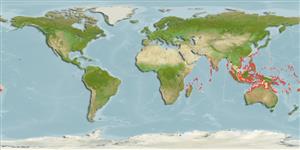>
Eupercaria/misc (Various families in series Eupercaria) >
Lethrinidae (Emperors or scavengers) > Lethrininae
Etymology: Lethrinus: Greek, lethrinia, a fish pertaining to genus Pagellus.
More on author: Valenciennes.
Environment: milieu / climate zone / depth range / distribution range
Ecologie
marien rifbewoner; standvastig; diepte 4 - 35 m (Ref. 90102). Tropical; 30°N - 21°S
Indo-West Pacific: Sri Lanka to the Marshall and Solomon islands, north to the Ryukyu Islands, south to northern Australia.
Grootte / Gewicht / Leeftijd
Maturity: Lm ? range ? - ? cm
Max length : 35.0 cm TL mannelijk / geslacht onbekend; (Ref. 2295); common length : 29.0 cm SL mannelijk / geslacht onbekend; (Ref. 37816)
Dorsale stekels (totaal) : 10; Dorsale zachte stralen (totaal) : 9; Anale stekels: 3; Anale zachte stralen: 8. Body is brown or tan, with scattered irregular small black blotches, a large oblong black blotch below soft-rayed portion of dorsal fin and bordering below the lateral line. The fins are pale or pinkish.
Solitary or in groups (Ref. 90102). Inhabits shallow seagrass beds, reef flats, lagoons, and sandy areas near coral reefs. Feeds on benthic invertebrates and small fish. Also caught with beach seines and handlines and is marketed fresh (Ref. 9775).
Levenscyclus en paargedrag
Maturities | Voortplanting | Spawnings | Egg(s) | Fecundities | Larven
Carpenter, K.E. and G.R. Allen, 1989. FAO Species Catalogue. Vol. 9. Emperor fishes and large-eye breams of the world (family Lethrinidae). An annotated and illustrated catalogue of lethrinid species known to date. FAO Fish. Synop. 125(9):118 p. Rome: FAO. (Ref. 2295)
Status op de Rode Lijst van het IUCN (Ref. 130435)
Gevaar voor de mens
Harmless
Gebruik door de mens
Visserij: van minder commercieel belang
Tools
Speciale rapporten
Download XML
Internetbronnen
Estimates based on models
Preferred temperature (Ref.
123201): 26.2 - 28.9, mean 27.9 °C (based on 396 cells).
Fylogenetische diversiteitsindex (Ref.
82804): PD
50 = 0.5000 [Uniqueness, from 0.5 = low to 2.0 = high].
Bayesian length-weight: a=0.01318 (0.00806 - 0.02156), b=3.00 (2.87 - 3.13), in cm total length, based on LWR estimates for this species & Genus-body shape (Ref.
93245).
Trofisch niveau (Ref.
69278): 4.0 ±0.64 se; based on food items.
Generation time: 1.9 ( na - na) years. Estimated as median ln(3)/K based on 2
growth studies.
Weerstandsvermogen (Ref.
120179): Hoog, minimale populatieverdubbelingstijd minder dan 15 maanden (K=0.5-0.7).
Fishing Vulnerability (Ref.
59153): Low vulnerability (25 of 100).
Nutrients (Ref.
124155): Calcium = 58.4 [39.8, 93.9] mg/100g; Iron = 0.962 [0.622, 1.426] mg/100g; Protein = 20.4 [17.8, 22.6] %; Omega3 = 0.139 [0.096, 0.203] g/100g; Selenium = 36.7 [22.7, 62.9] μg/100g; VitaminA = 31.3 [6.7, 176.2] μg/100g; Zinc = 2.14 [1.59, 2.81] mg/100g (wet weight);
